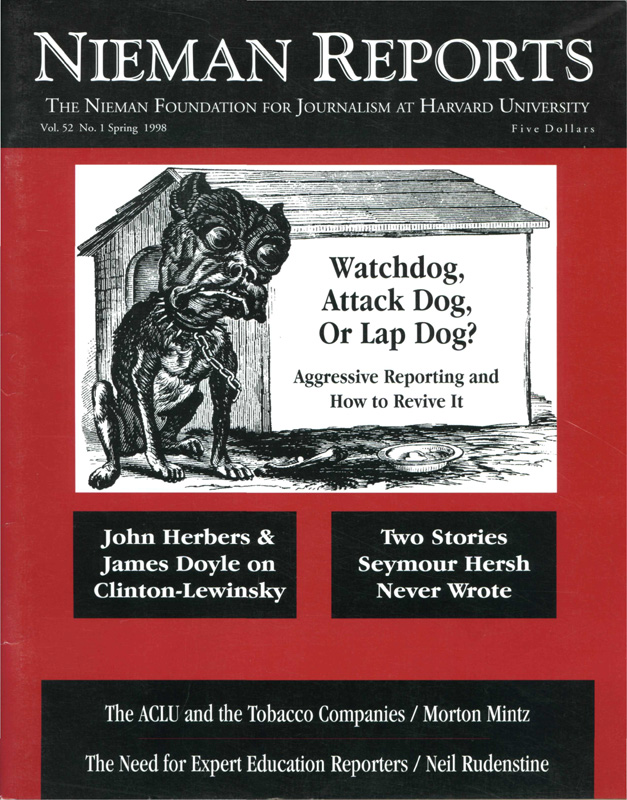Americans are the most generous people in the world, donating more to charity each year than the gross national products of many countries—some $120 billion, all told. As George Rodrigue argues convincingly, the media has done less than it could to illuminate the workings of the organizations to whom this money is given on faith. But Rodrigue touches only lightly on the less-than-complete financial accountability of nonprofits, and the concomitant difficulty for donors of assessing how effectively their contributions will be used to promote good works.
Unlike most European countries, the United States has no federal agency with which charities must register. Understaffed state attorneys general and consumer affairs bureaus often respond to complaints by referring donors to the Better Business Bureau, which, like the National Charities Information Bureau and other private-sector watchdogs, has virtually no teeth. Ironically, most prospective contributors get their information from Money magazine’s widely quoted guide to the "Best Charities in America."
Most of the organizations that make Money’s top 25 list are relentless in letting potential donors know they’re among the "best managed" charities in the United States. Reassuring as that may sound, Money gets most of its information from a trade publication, the Nonprofit Times—supported in large part by subscriptions and advertising from the charitable industry— which simply ranks charities according to the percentage of income they allocate to programs as opposed to management or fund-raising. In the world of nonprofits, a pie chart showing at least 80 percent of income dedicated to program expense has become the unofficial hallmark of an efficient and effective organization. "Save the Children is proud of the high proportion of our funds that we dedicate to program services directly benefiting those we serve," says the message accompanying that well-known charity’s 1995 pie chart, which shows an impressive 85.3 percent of its income devoted to "program services." While most major charities hit the 80 percent target, there’s a fair amount of legal fiction behind those calculations.
The first page of the federal tax return filed by nonprofit organizations, IRS Form 990, reports the allocation of total expenses among programs, overhead and fundraising. It is from these totals that come the numbers published by Money, and which go into the charities’ ubiquitous pie charts. Look deeper into Form 990, and the fiction gradually becomes apparent. Within those three broad categories, expenses are divided into subcategories like salaries, benefits, rent, legal fees, travel and telecommunications, and it is there that the IRS permits nonprofits to obscure how they actually spend their money. Save the Children,which is by no means unique among nonprofits, filed a federal tax return for the 1996 fiscal year reporting program expenses of $94 million, compared •with $7.2 million for management and overhead and $13.3 million for fundraising.
Save the Children’s contributors might be forgiven for assuming that nearly 82 cents of every dollar they sent Save the Children had bought school supplies for African children. Peel back the layers, however, and "program expense" includes salaries of $17.5 million—more than three-quarters of Save the Children’s total payroll—as well as 89 percent of the organization’s travel budget and 87 percent of its occupancy costs. Other "functional" program items include legal fees ($97,102), office supplies ($13.2 million) and $14 million for "other project costs, other professional fees, advertising and miscellaneous." If the expenditures for salaries, benefits and other management expenses labeled as "program" are shifted to "management," Save the Children’s program expense would decrease from 82 percent to 39, while its management expense would increase from six percent to 49.
Most nonprofit organizations "functionalize" their expenses in the same way, and they argue that salaries paid to employees who arrange the delivery of school supplies to African villages represent a legitimate program expense just as surely as the cost of the school supplies themselves. The same argument presumably applies to fees paid the lawyers who draft the contracts for purchasing the supplies and to the telephone bills incurred in arranging for their shipping and delivery. If that sounds reasonable, then by extension Save the Children might as well claim that since its only business is helping children, every last penny it spends, from limos to light bills, is a program expense. Beyond the fact that functionalizing salaries and other overhead expenses allows a charity to be as wasteful and inefficient as it likes, a pie chart that showed 100 percent of every donor’s dollar going to programs would be beyond belief, just as one showing 39 percent would be likely to put a major damper on contributions. By shuffling expenses between this category and that until the 80 percent threshold is reached, a reasonable fiction is created.
The IRS, which doesn’t pay much attention to nonprofits in the first place—less than two percent of all 990’s were audited in 1996—also doesn’t care how a charity apportions its expenses among programs, management and fundraising. What matters to the IRS is whether a charity has spent its money on something besides its primary charitable business, or has conferred an "inordinate private benefit" on one of its officers. In the extreme case, a charity that wanted to appear ultra-efficient could appear to be claiming that 90 percent of its donations had been used to pay for its programs when the real figure was 20 percent, and still escape the IRS’s wrath as long as it wasn’t making a profit. But explaining functionalized accounting, and what it means to potential donors, is something the media can do better than any government agency or watchdog organization—and ought to.
John Crewdson, a senior writer for The Chicago Tribune based in Washington, recently participated in that newspaper’s exam.


